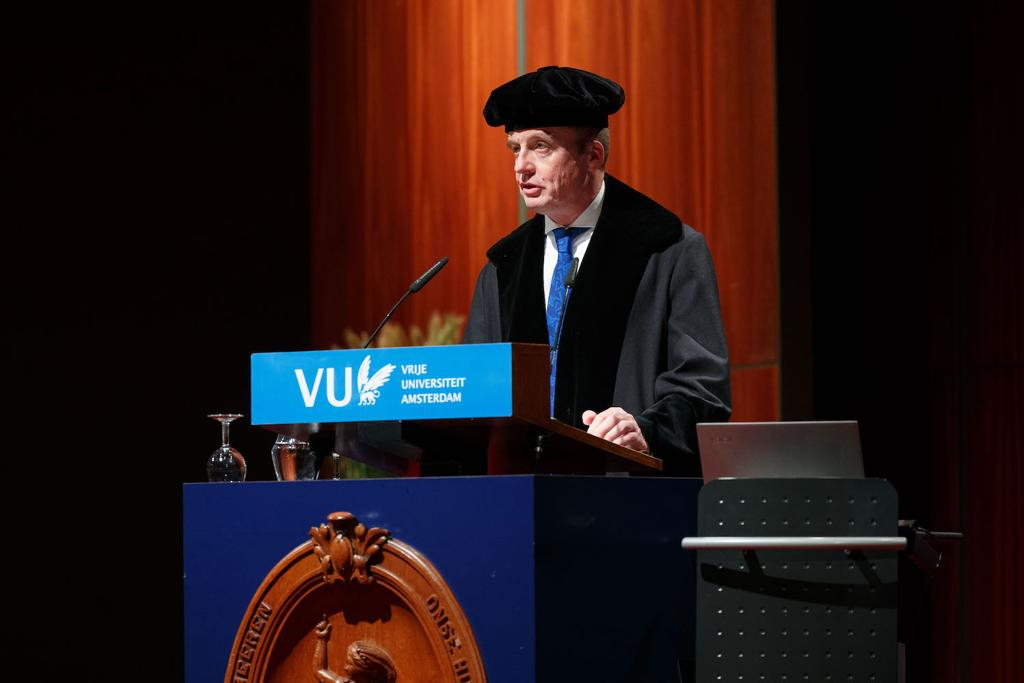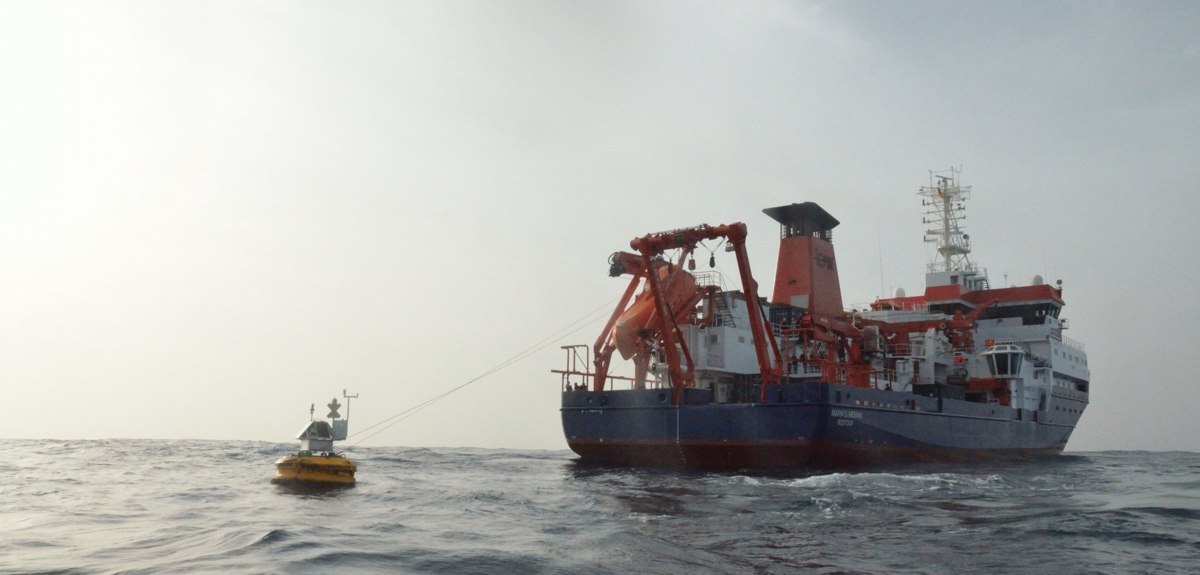
The aim of the expedition is to study sinking particles from sea surface towards the seafloor. The particular aim of the four NIOZ colleagues is to service dust-collecting buoys Carmen (off Cape Blanc, Mauritania) and Laura as well as high-resolution sediment-trap mooring M1 (both south of Cape Verde Islands) which have been collecting many particles, including Saharan dust, since we deployed them during RV Pelagia expedition 64PE482 in February 2021. In addition, we will be collecting dust with various instruments.
In the blog below you can follow our whereabouts and adventures at sea.
Another blog for this cruise is being kept on the MARUM website.
Regular updates below this part, latest update on top:
15 December – the SIPA dreamteam
All good things come to an end, also this dusty research expedition. On behalf of the SIPA dreamteam (L2R: Eldo, Jan-Berend, Kristina, Daan, Melina, Michael, Götz, Jan Dirk, Joshua, Marco, Alek, Gerard, Hendrik, Eduardo, Karin, Bob, Leon, Aman) we thank Master Björn and his dreamteam of officers on the bridge, bosun Enno and his dreamteam on deck, Chief Engineer Sven and his dreamteam in the machine room and chef Matthias and his dreamteam in the pantry. We were spoiled with great food and comfort, a very pleasant working atmosphere and many present surprises from the ever-cheerful Sylvia. Many thanks and looking forward to the next time!
With that this blog is closed, many thanks for following and see at the next!
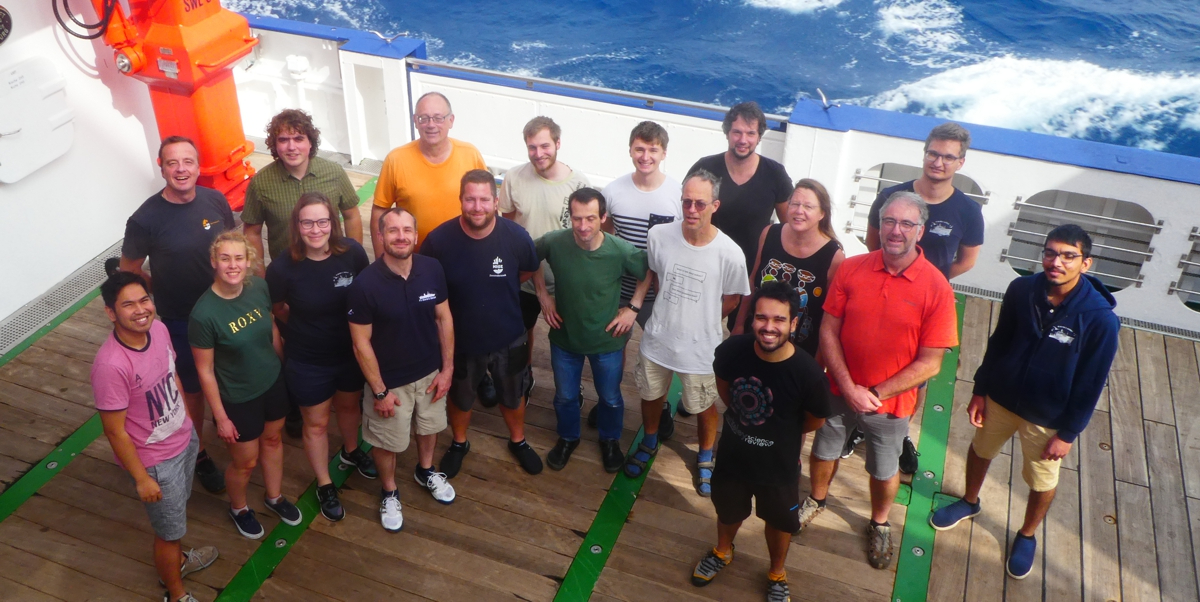
14 December – dust on satellite images
NASA offers daily satellite images on the Eosdis website with two overpasses every day; the Terra/MODIS overpass is in the morning and the Aqua/MODIS in the afternoon. These two images are also combined –to get rid of the black bars that are the result of the satellite’s orbit around the rotating earth— into a daily average but on the ‘raw’ images used for this animation, the Saharan dust plumes can be seen more clearly. One can clearly see how during the period that we were in the area off Mauritania, dust plumes started to be blown across Cape Blanc onto the Atlantic Ocean on 28 November, and they hardly stopped since then; we have been truly lucky to witness so much dust in so many events!
The dust-collecting buoys offer the unique opportunity to calibrate these satellite images as they monitor and collect information not only on the meteorological conditions at sea but also on quantitative amounts of dust per m³ air. In addition, the new add-on to the buoys --the wet-dust collectors-- will give us information on how much Saharan dust is deposited on the ocean with rain. The synchronised collection of sediments by the submarine sediment traps will hopefully provide information about the marine environmental effects.
14 December – dust on deck
Now that we are approaching the Canary Islands from the south, it is clear that we are leaving the dusty region off Mauritania. Although the AB’s have cleaned most of the ship, here and there are some traces to be found of Saharan dust washed into little orange specks on the green deck.
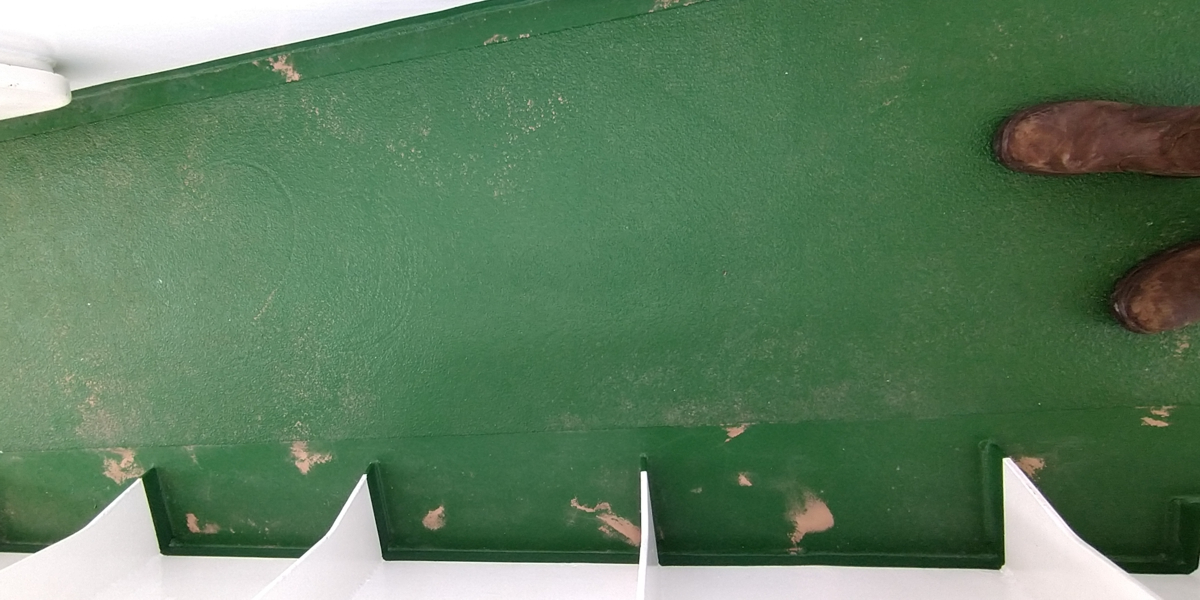
13 December - washing machine
No dust without wind, but these winds also whip up waves! Although RV Maria S. Merian sails very smoothly, now and then she dips into the ocean, filling the portholes in the mess, making them look like a washing machine....
12 December – Dusty sunrise
Once more we realise how lucky we are to do this work; enjoying another dusty sunrise at sea.
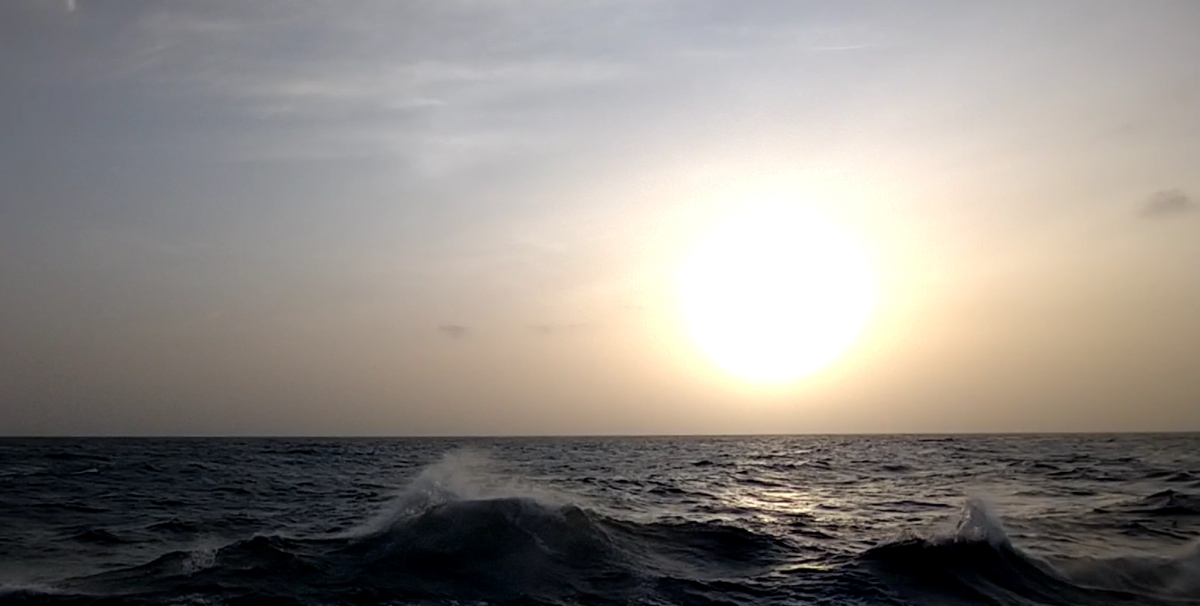
11 December – dusty buoy filters
This is what we have been hoping for; nicely orange-coloured filters loaded with Saharan dust! The catch that has been collected since January this year is really excellent; virtually all filters contain some material, which we will process and analyse in the labs back home.
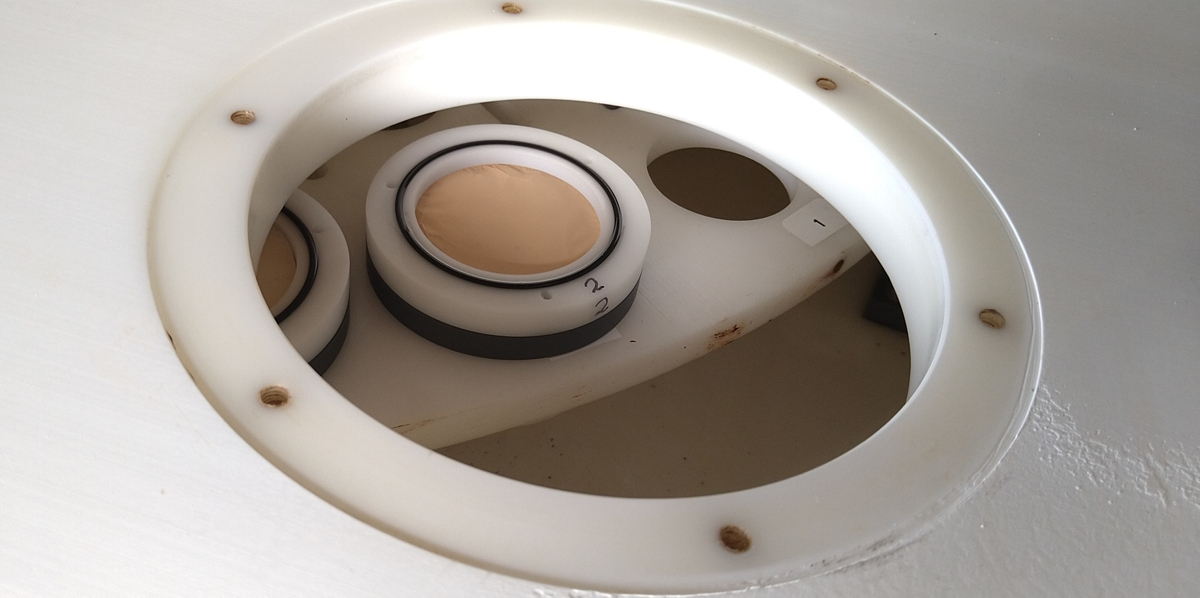
11 December – Teamwork
After more than three weeks at sea now, the NIOZ & MARUM technicians, bosun Enno and his men on deck, and master Björn and his officers both in the dinghy as well as on the bridge, are working as a team as if they never did anything else. Dust buoy Laura was recovered and re-deployed within 2½ hours, an excellent team effort!
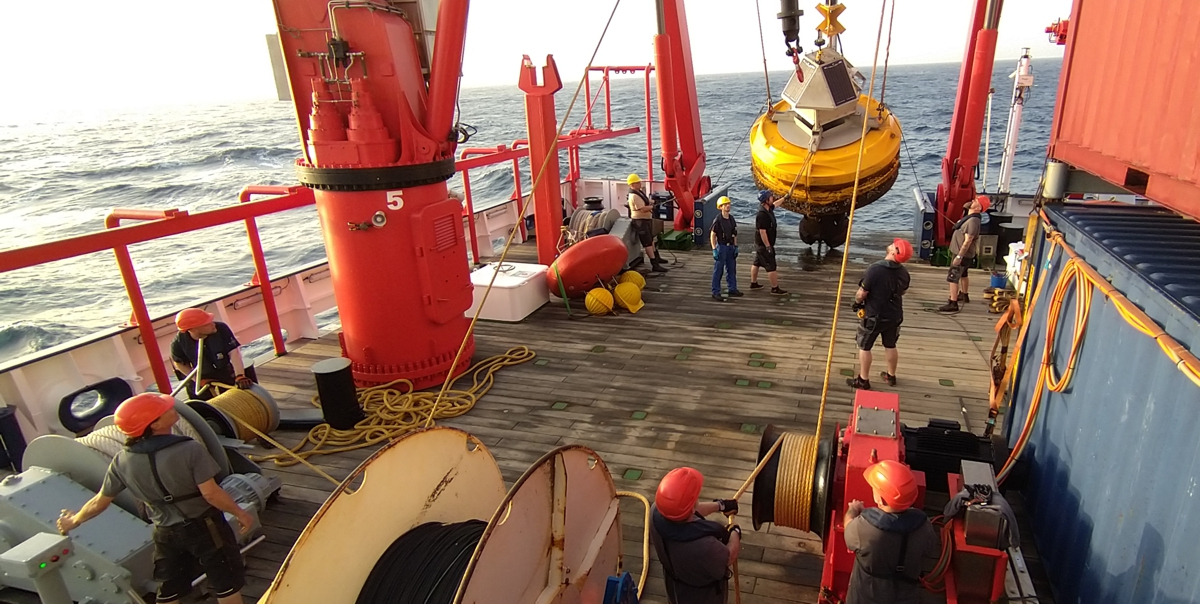
10 December – Buoy in the dark
Both buoys Carmen and Laura are tethered to cables that are longer than the water depth they were deployed at. As a result, they have a small ‘circle of freedom’ to move about. Given that the Trades are mostly pushing the buoys towards the southeastern part of their circle, and since twice a day we get a mail with the whereabouts of the buoys, we know where to look. Yet, the easiest way to find them is to look in the dark when the flash light can be spotted from miles. We all enjoy the reunion with buoy Laura and look forward to recovering her first thing in the morning!
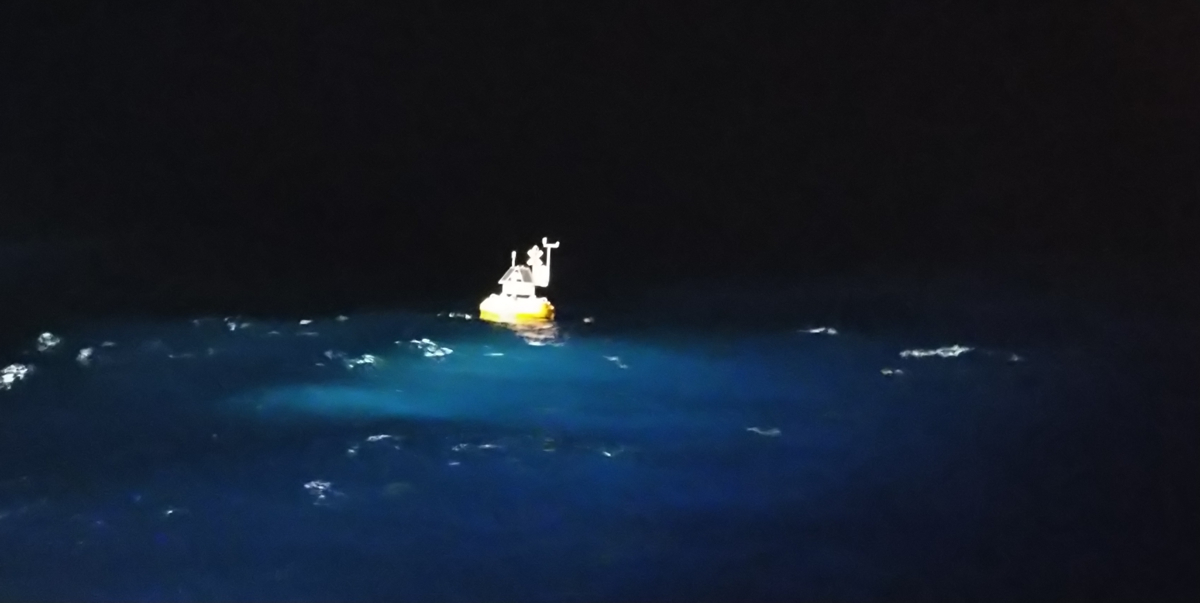
9 December – All hands on the bridge
Today we are recovering the sediment-trap mooring that has been collecting material settling down the water column since we deployed her last January during RV Pelagia expedition 64PE482. This mooring consists of three sediment traps consisting of 39 bottles each, allowing a temporal crazy high resolution of two days. This means that we can potentially distinguish individual dust storms! The traps have been ‘hiding’ completely in the deep ocean (the ocean floor is more than 5,000m below the ship!) and after NIOZ technician Bob gave the acoustic command to release the anchor, the floats in the mooring are making their way up to the ocean’s surface. First we have to find her and to this end, there are many people on the bridge, hoping to be the first to spot the bright orange floats.
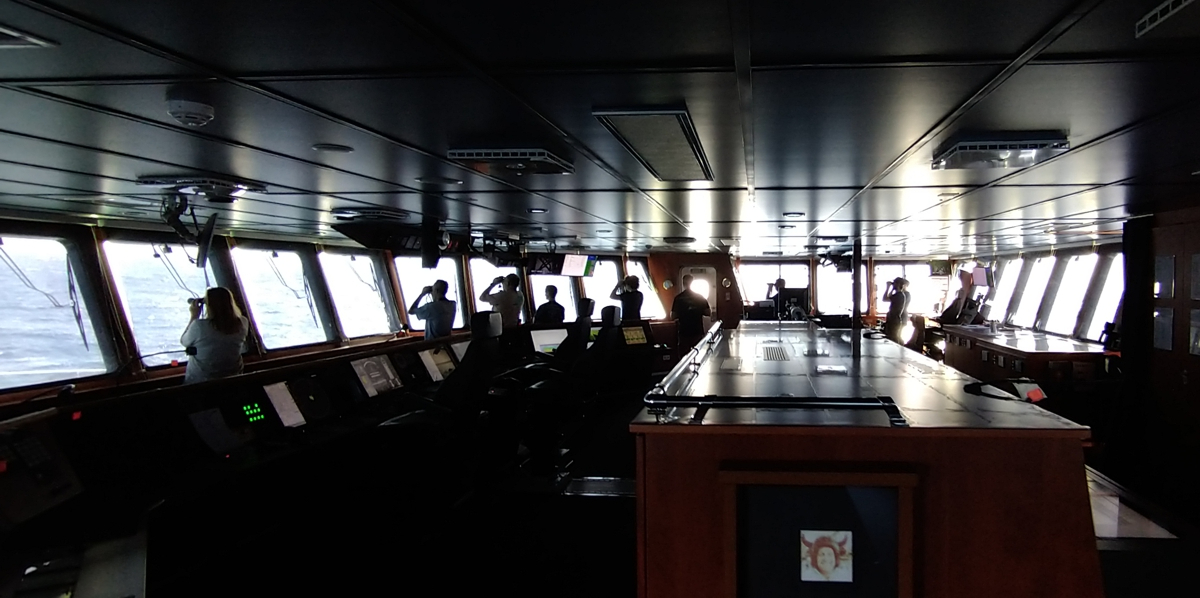
8 December – Drifting-trap results
The drifting traps have been floating freely for about one day each in this time they have collected a lot of particles (SIPA is all about particles!) but also a lot of little creatures that are living in the ocean. Just out of curiosity we have looked at these creatures that we have filtered out of the water in the drifting traps. Some of these fascinating little creatures consist of jelly-ish material like jellyfish, some are made of organic silica and some of calcium carbonate. The top left shrimp was photographed at 10x magnification, all other images at 200x.
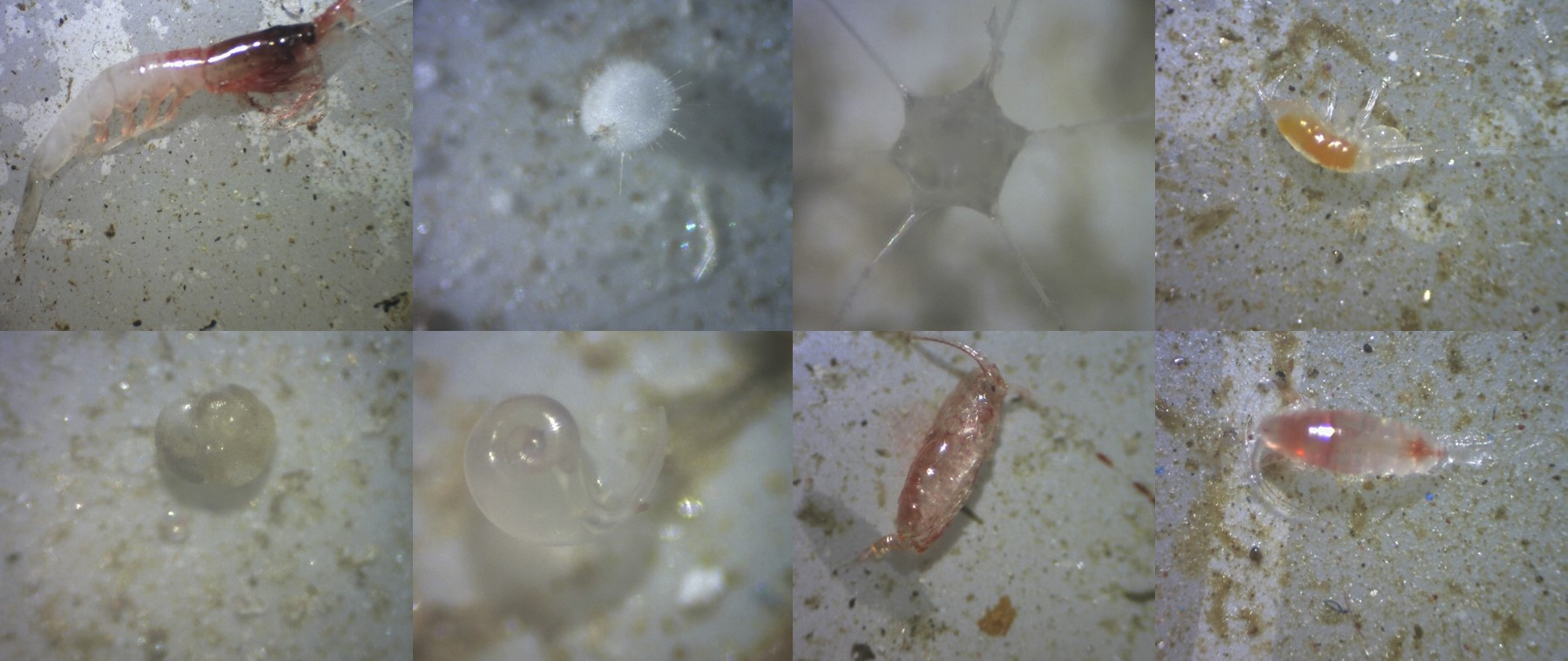
7 December – In dust, we….
Just before reaching the Canary Islands (now that feels ages ago!) we had installed one of the prototypes rain collectors on one of the higher decks of RV Maria S. Merian. Now it was time to check if the rain measured by the rain sensor (the transparent dome on the top right) corresponds to the amount of water collected by the catcher under the black lid on the left.
Despite the few rain showers we had so far, it is clear that there is a coating of dust mixed with salt all over the collector.
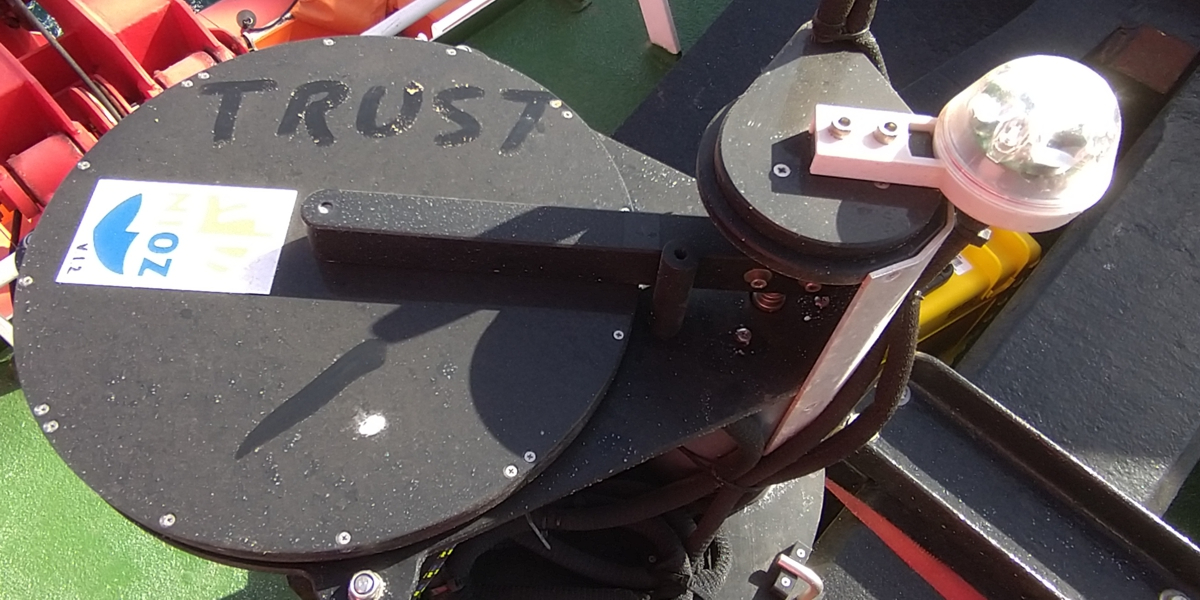
6 December – Hooked
While leaving the Cape-Blanc area, heading south towards buoy Laura, we are still sailing through a cloud of Saharan dust, causing scenic dusty sunsets.
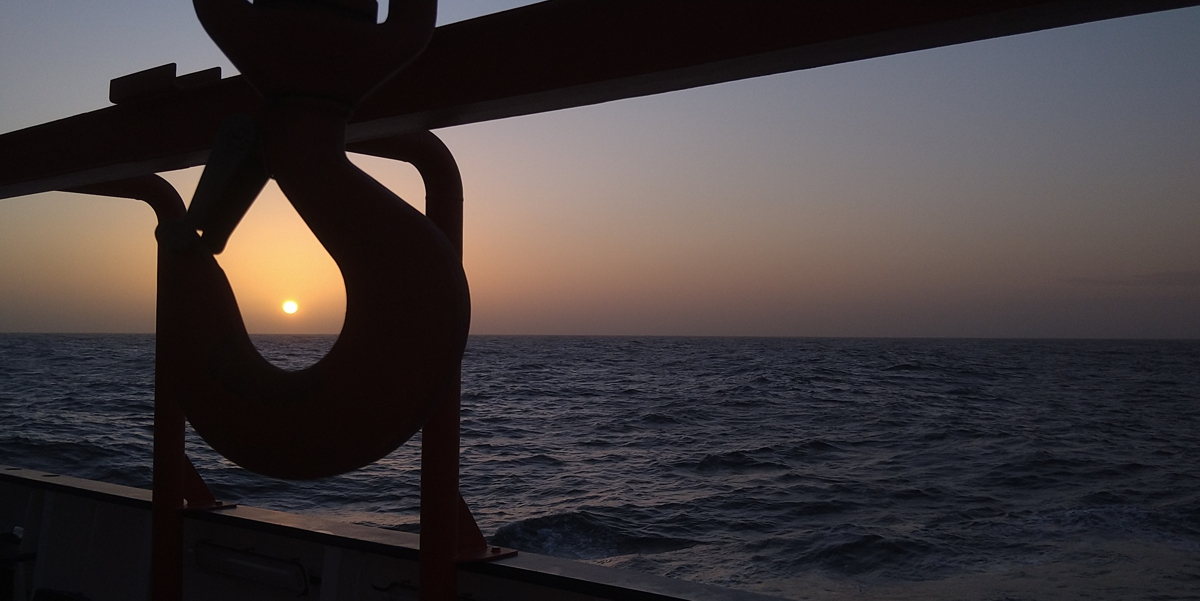
Somehow sun-ups seem less spectacular than sun-downs but the last few mornings we started with the recovery of the drifting traps and this morning the view out of the mess window treated us to both: a nice (dusty!) sun-up as well as a rare sight: the drifting traps floating by.
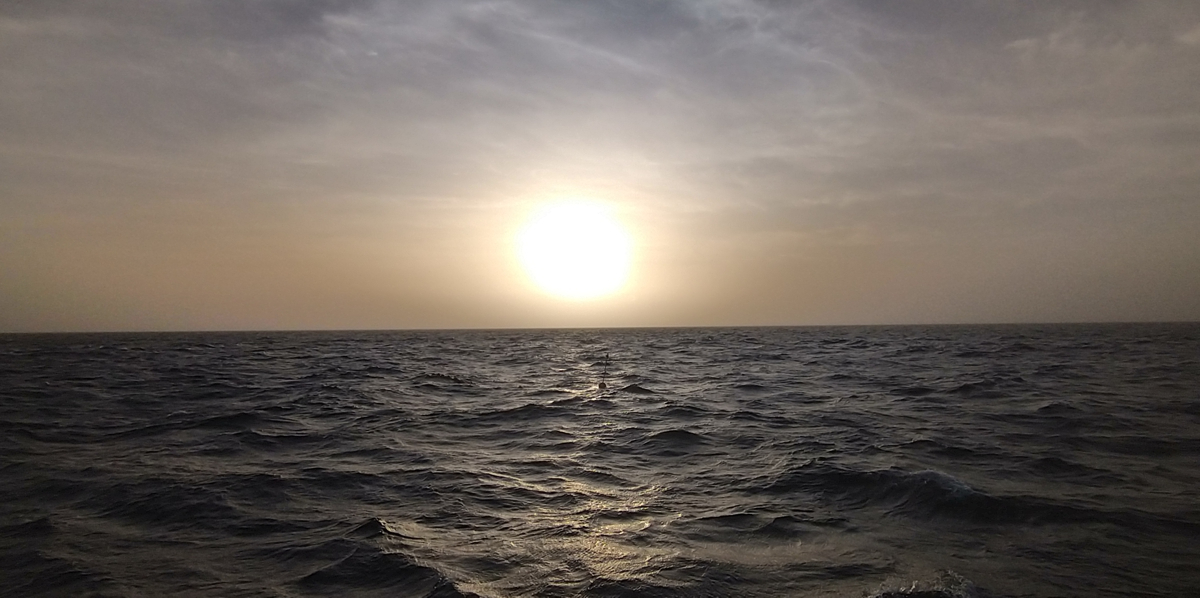
5 December – Cup deformations
Per 10m water depth, the ambient pressure increases with 1bar. This is why we like to state that deep-sea research is much more difficult than space research; all our instruments need to be able to handle the enormous pressure differences. One way to visualize the pressure increase with depth is by sending styrofoam cups to the deep; all the air is pressed out of the foam and cups get small and rock hard. Since the pressure is in all directions, the cups maintain their shape and the decorations stay intact. These cups have been down to 2,500m = 250bar pressure. A pristine cup is shown for comparison.
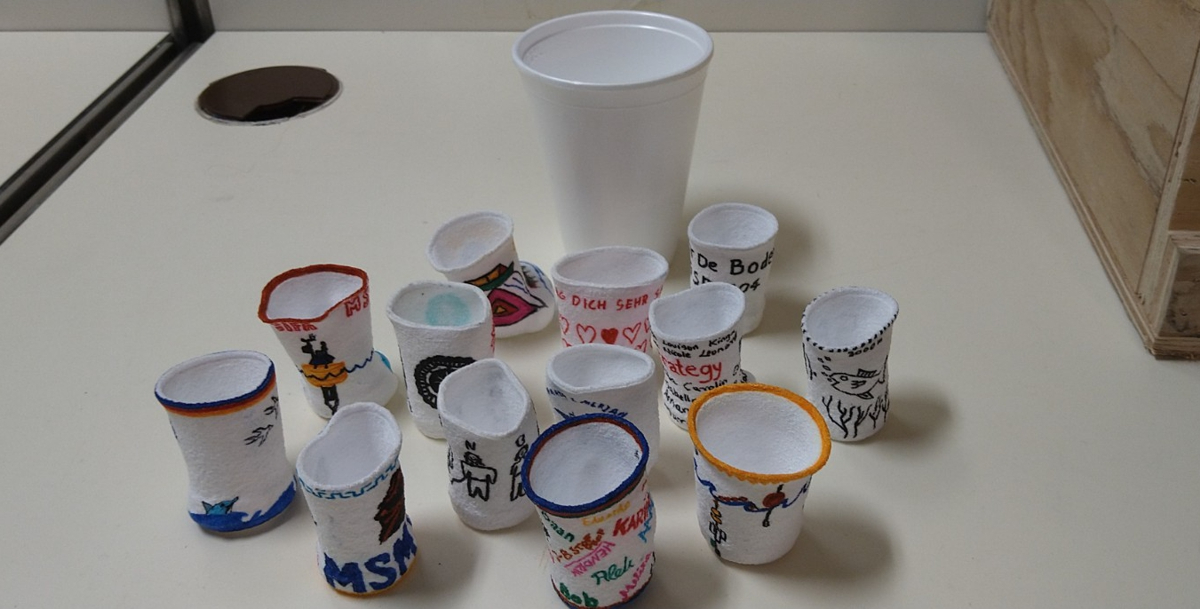
4 December - SIPA: Sinking Particles (and their fate)
The ultimate stop for the particles that we are studying is the seafloor, now some 1,500m below the ship. To sample the sediment stack that is piling up on the sea floor, there are several devices. Since we are most interested in recent sedimentation processes, we focus on the sea-floor surface, which can best be sampled using a so-called multicorer (MUC). This multi corer allows simultaneous sampling of N=12 50-cm long cores at the same time, which are then distributed amongst the different scientific disciplines. Here you see various team members of SIPA in their colourful overalls, sampling in their specific ways that are needed for the specific analyses to be carried out later in the lab. These analyses vary from microplastics to particle-size analysis, various kinds of organic matter and biomarkers, dinoflagellates, foraminifera, diatoms, coccolithophores etc.
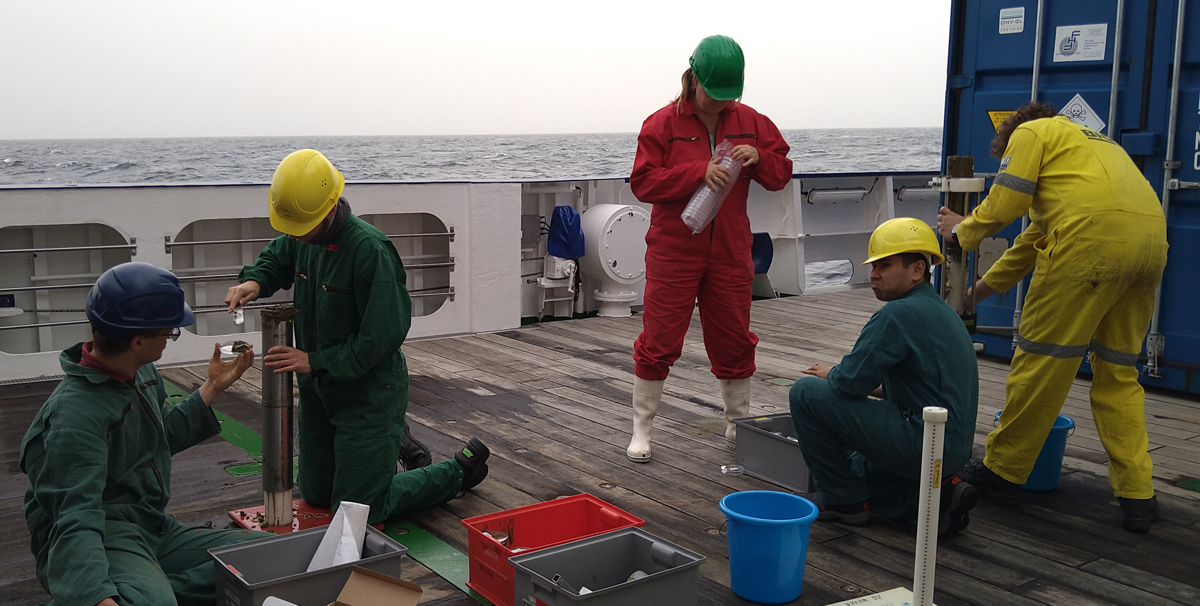
The big advantage of the MUC is that the sediment-water interface stays intact inside the tube; this is what the seafloor looks like (although it is pretty dark at 1,500m). The sediments are greenish thanks to the amounts of organic material and despite the deposition of orange dust.
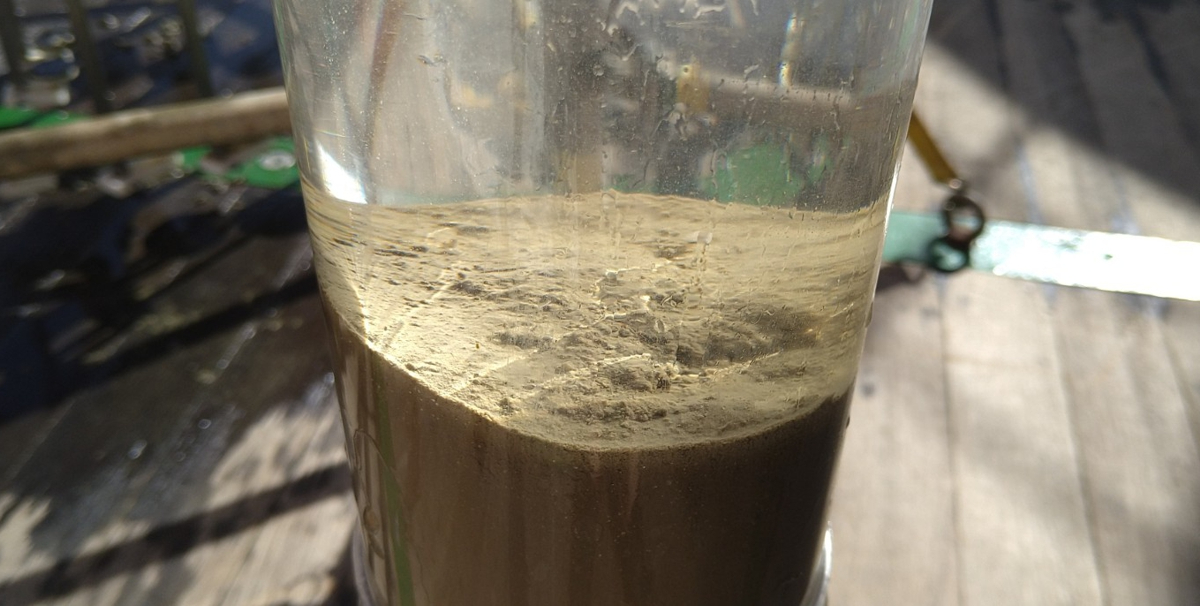
3 December – dust forecasts
Nowadays there are excellent forecast models for mineral-dust emissions. One of those is Windy.com, which allows three-day forecasts. Four of these forecasts are combined in this clip to demonstrate that there indeed is a lot of dust in our study area off the Mauritanian coast at the moment. The buoy positions are indicated and the general ship’s track as well.
The animation nicely shows how there are several hotspots of dust emissions on the north-African continent. A few famous ones are in Chad, Algeria and on the west-African coast: in West-Sahara, Mauritania and Senegal. This model run also shows that by far not all dust travels westwards and it also clearly demonstrates how about 75% of the dust is deposited on the continent and only about 25% makes it out to sea (Shao et al., 2011 Aeolian Research 2, 181-204). Recent satellite studies estimate that every year about 182 million tons of dust are blown west from the northwest African continent (Yu et al., Remote Sensing of Environment 159, 232-249) across the Atlantic Ocean towards the Americas.
2 December - dust-fog
Next to all the marine-environmental consequences and potential of mineral dust, a very direct effect of all this material blowing through the atmosphere is a reduced visibility. Under normal conditions with clear skies, visibility at sea would be around 12-15nm (nautical miles, 1nm = 1.85km) but with this dust-fog it is reduced to less than ~3nm. Fortunately, RV Maria S. Merian's radar has little trouble 'seeing' through the fog.
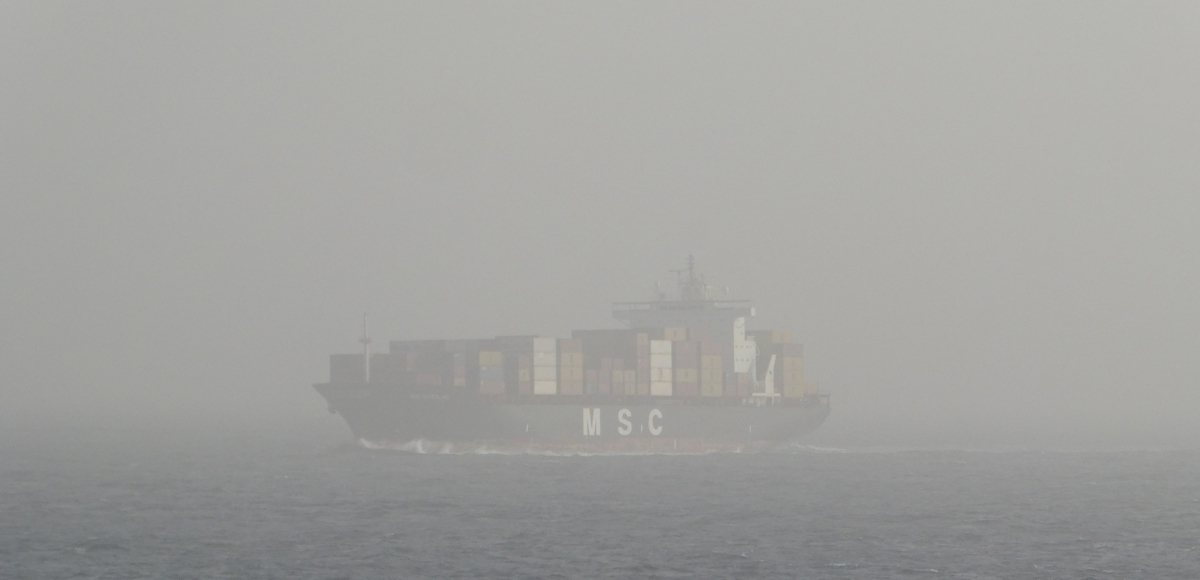
1 December - dust all around
As expected, the eastern Trades that picked up yesterday are carrying large amounts of Saharan dust! There is so much dust around that visibility is drastically hampered. The setting sun cannot penetrate through the dense layer of dust hanging over the ocean, such that it has disappeared long before it sank into the ocean as it normally would have.
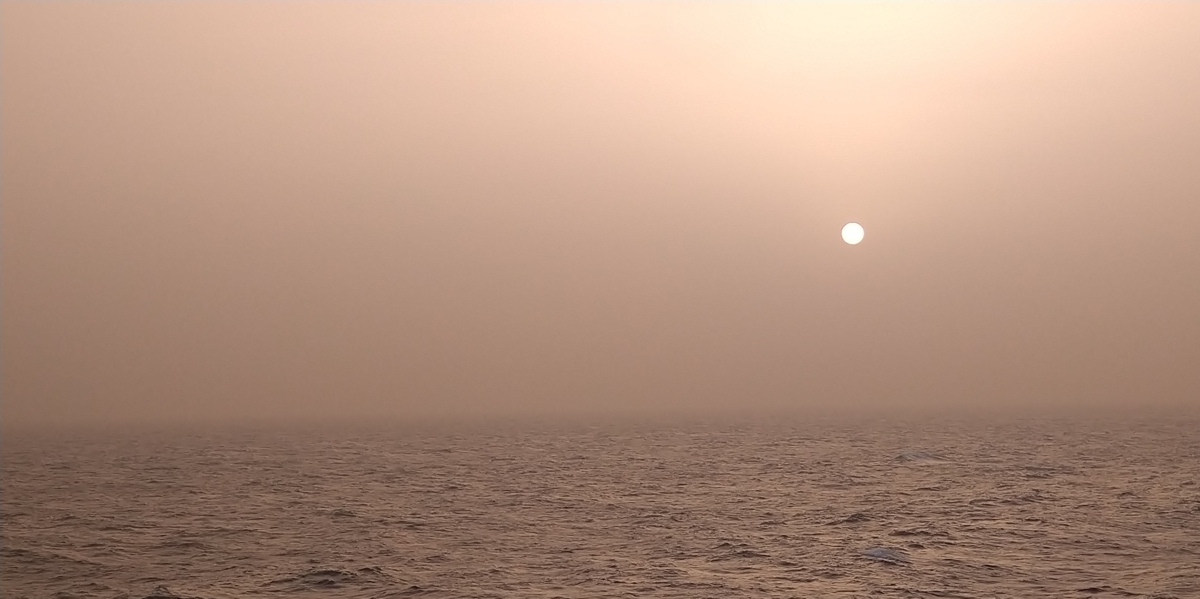
With the high-volume dust collectors on top of the bridge (see post of 20 November) large volumes of air are pumped through filters. The effect is clear and the colour matches that of the atmosphere: Saharan dust!
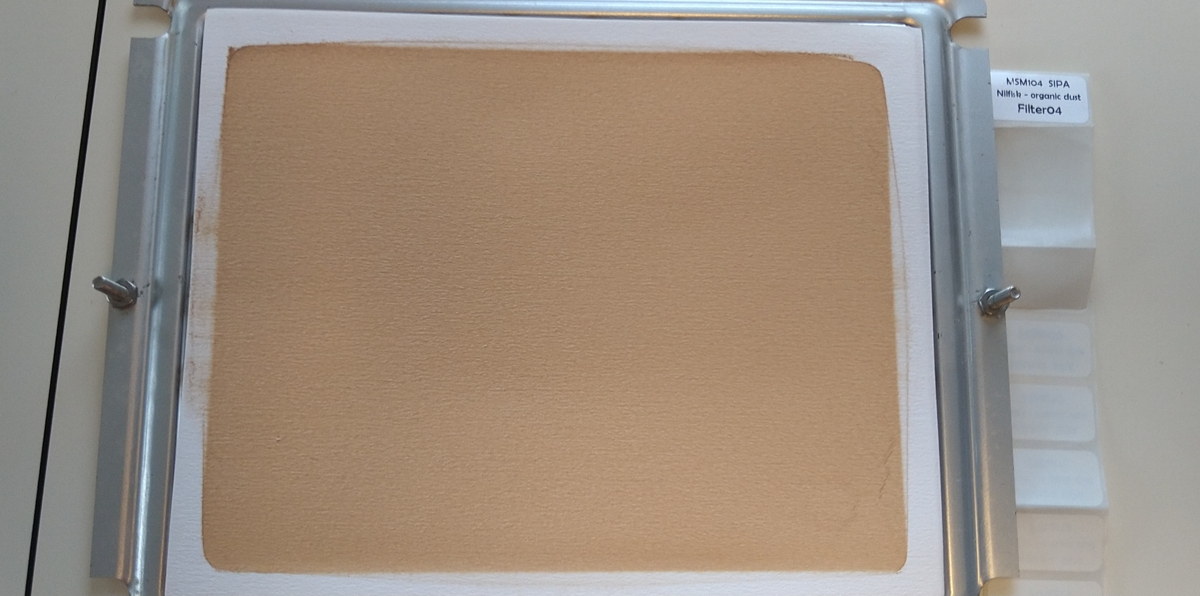
30 November - no dust without wind
The wind has picked quite nicely, which means that chances on Saharan dust are increasing. However, the strong winds (up to 19m/s ~Bft 8) also whip up the waves, as you can see in this YouTube clip.
29 November – how’s the weather?
Every day at exactly 10.30 UTC all over the Atlantic Ocean weather balloons are launched from ships to get an idea about the meteorological conditions in the atmosphere. These daily measurements are used by all kinds of met-offices in Europe and the data flow into computer models to make the weather predictions more accurate. The DWD – Deutsche Wetter Dienst installed a dedicated meteo-container on the Maria S. Merian to participate in this measuring program and the ship’s electronic officers launch a balloon every day.
28 November – drifting traps
The theme of this cruise is SIPA – Sinking particles (and their fate in the water column) and one way to sample them is with so-called drifting traps; a set of open-top tubes that are suspended vertically and left to drift freely for a given set of time. In this case we let them ‘on their own’ for 36 hours.
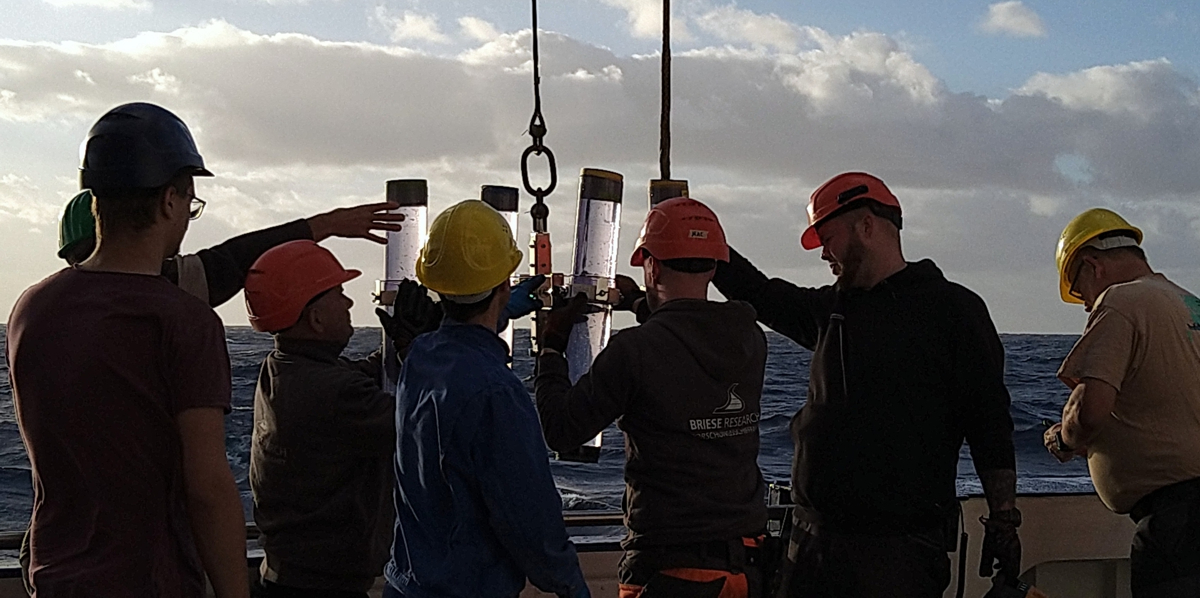
It is actually amazing how much material these devices collect in such a small amount of time. The green parts you see here are so-called faecal pellets; organic-material aggregates, or simply: zooplankton poo. Some white particles are individual zooplankton like copepods or pteropods.
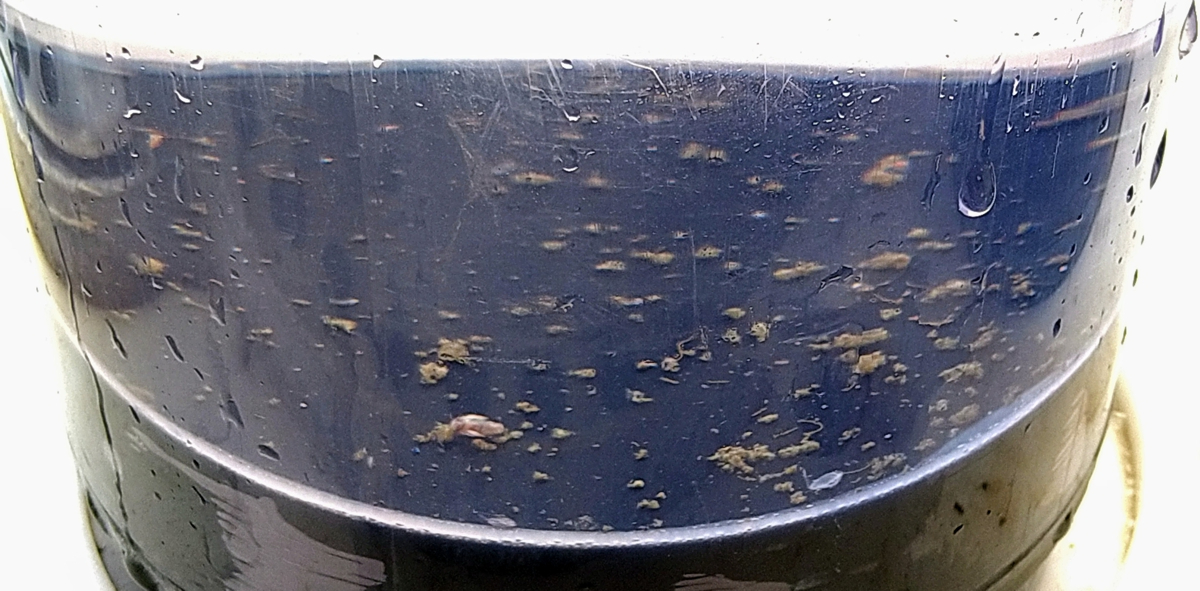
27 November – recovery day
Today we had a busy program with the recovery of both a sediment-trap mooring and dust-collecting buoy Carmen. Thanks to great teamwork between Master Björn and his officers both on the bridge and in the dinghy, bosun Enno and his team on deck and the MARUM and NIOZ technicians, it all went very smoothly and successfully! Now it is time to see what samples the and data the instruments have collected….
Edible samples
Typically, the buoys are overgrown with gooseneck barnacles, which turn out to be considered a delicacy in e.g. Portugal. First cook Matthias took up the challenge and prepared a few of the barnacles. Like shrimps, one had to put a bit of effort in getting the edible parts out but we all tried and enjoyed the unexpected treat!
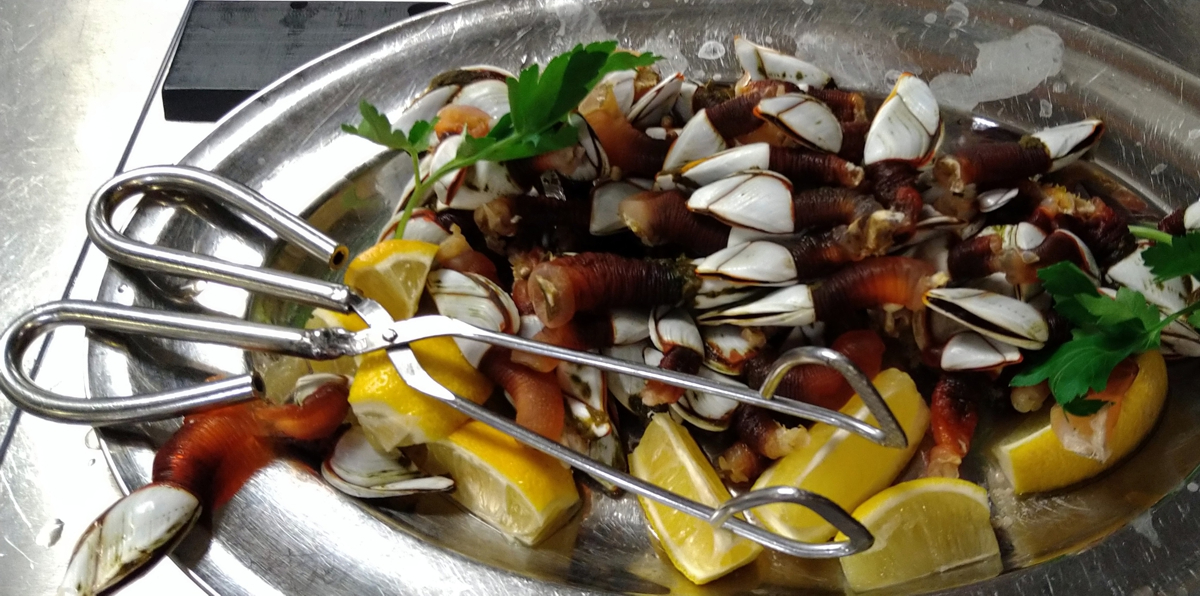
26 November - a dusty sunrise
Yesterday we had already observed a kind of hazy atmosphere. Where in Europe this haze is usually caused by small water droplets, in the area offshore the largest modern dust source in the world it is dust.
This dust can be most easily seen at both sunrise and sunset, when the sun's rays travel long distances through the atmosphere, where they encounter and are dispersed by many more of these dust particles relative to later during the day when the sun is high in the sky.
So, why are these sunrises and sunsets often accompanied by red colours?
.....the answer my friend....
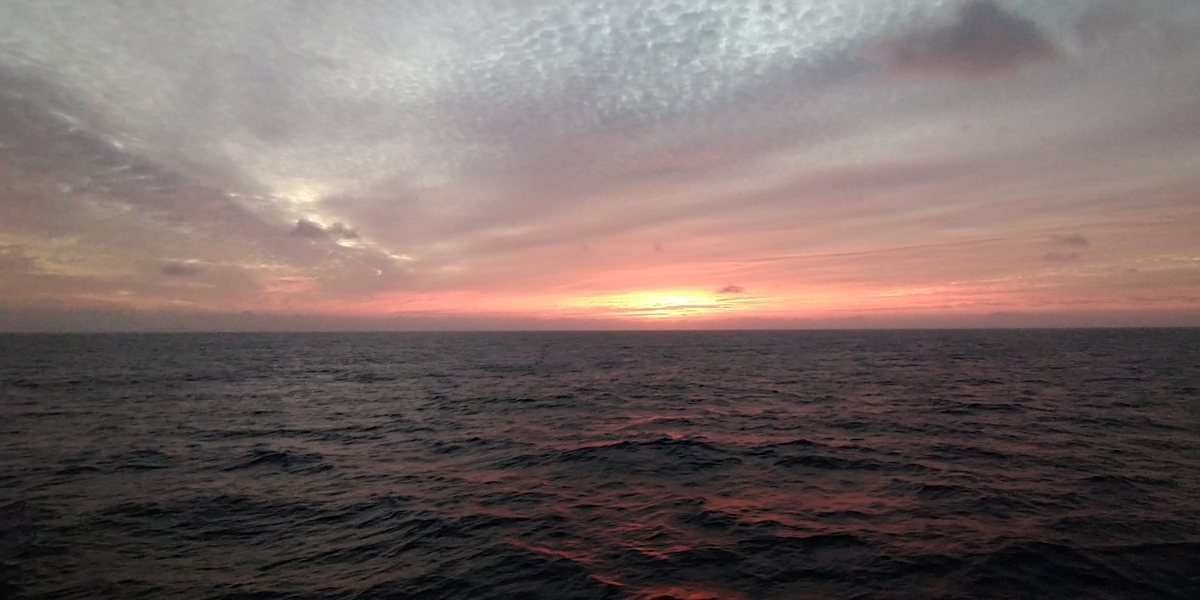
25 November – A geologist’s dream
In the early morning, about one hour before sunrise, we pass West of the island of La Palma, which has been suffering from volcanic eruptions for more than a month now. There were several options for the transit to our study area off Cape Blanc Mauritania and we agree that this was the best option; right past the side of the Cumbre Vieja volcano that is still actively producing hot lava.
For the geologists in the team a thing to be ticked off their bucket lists and for all on board simply a spectacular sight!
![Hot lava streaming down the slope of Cumbre Vieja on La Palma [photo credit: Daan Eldering] Hot lava streaming down the slope of Cumbre Vieja on La Palma [photo credit: Daan Eldering]](/application/files/1616/3785/5390/11-25_la-palma-lava.jpg)
24 November – Land ahoy!
Right after breakfast we see some islands on the horizon: Madeira and its acompanying islets. This used to be a famous area for whale spotting, so we are keeping an extra eye out!
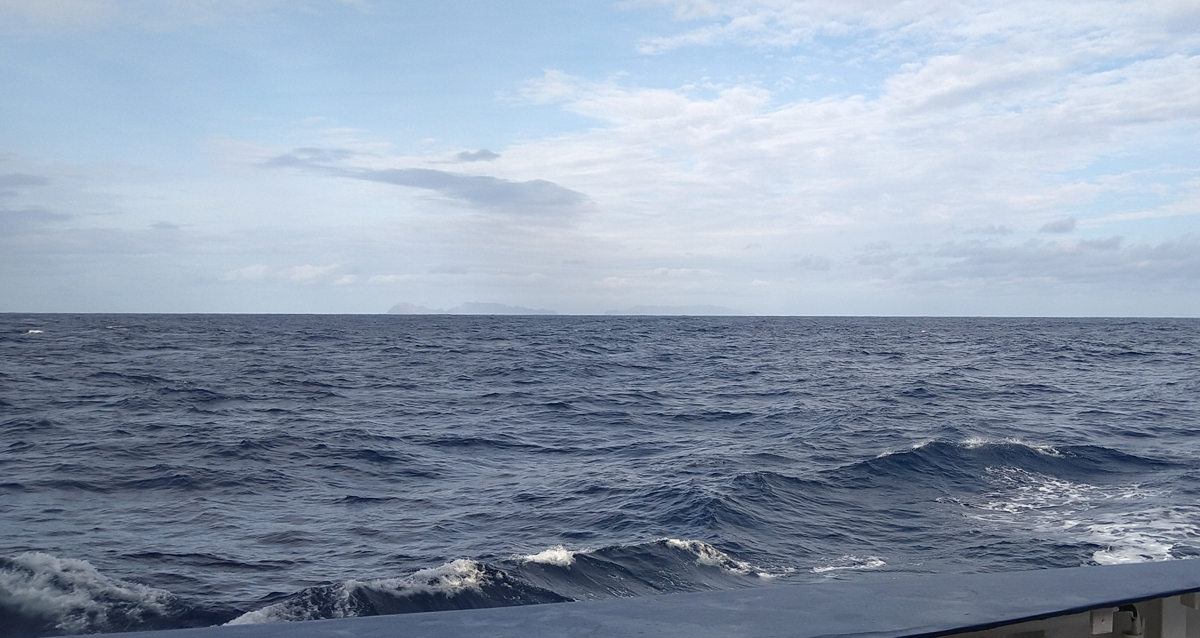
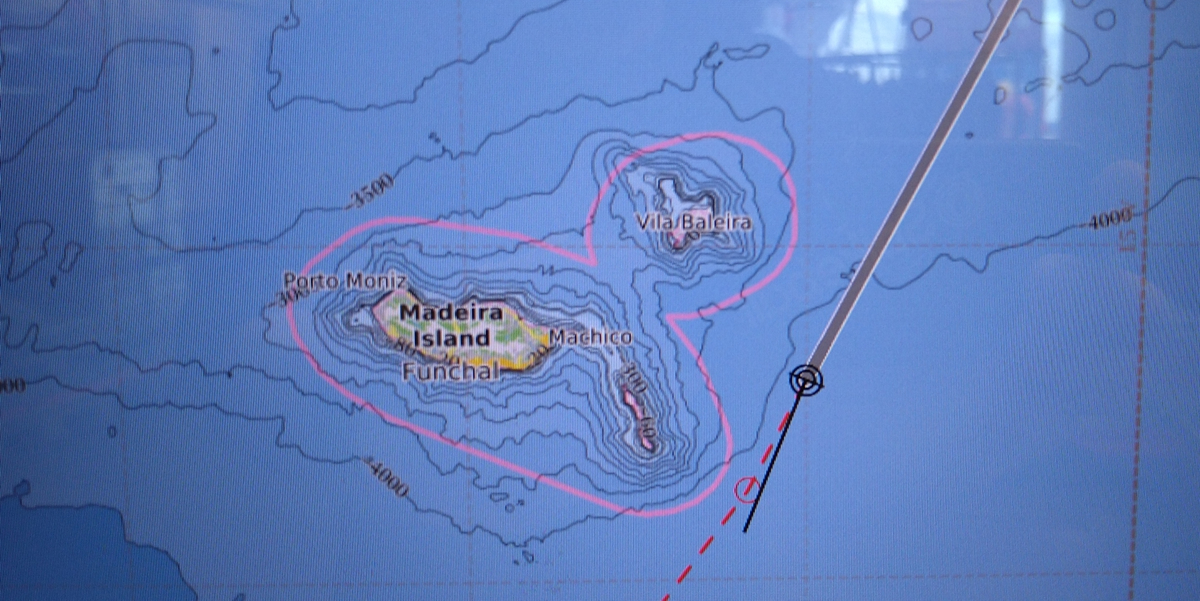
23 November – a pot of gold?
With the rising sun on portside and rain on starboard, a beautiful rainbow can be seen from the aft deck. An excellent morning treat! We are tempted to ask Master Björn to steer towards it, to fetch the pot of gold.
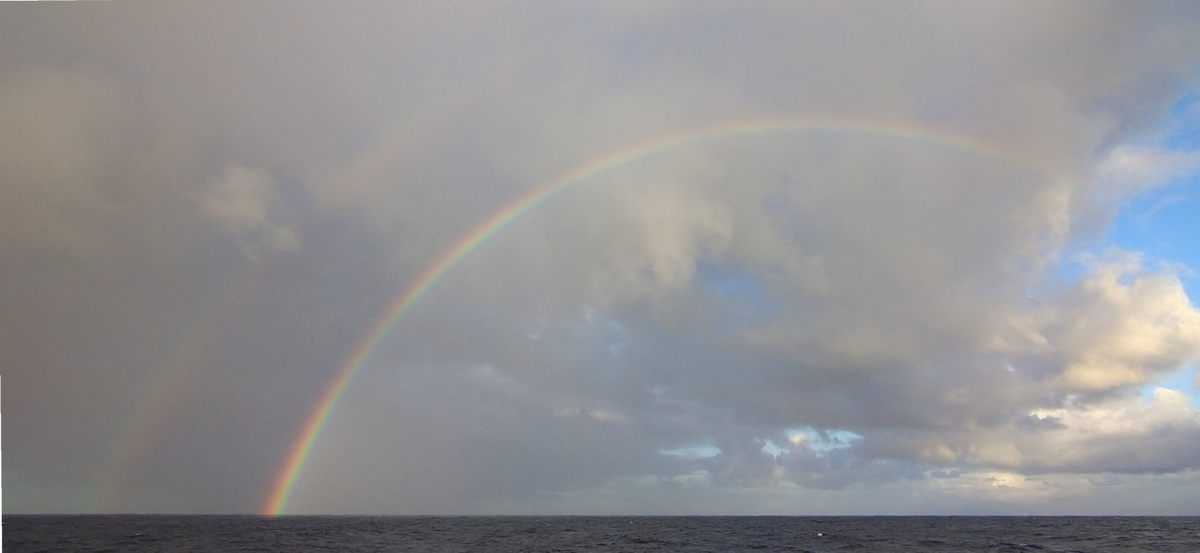
22 November - little stowaways
Since passing through the Bay of Biscaye, we have a few little stowaways on board; some finches and a robin. They are curious little fellows and one of them was caught by Daan checking out the books that are lying around in the hangar....
![A little stowaway studying books in the hangar of RV Maria S. Merian [photo credit: Daan Eldering] A little stowaway studying books in the hangar of RV Maria S. Merian [photo credit: Daan Eldering]](/application/files/3916/3758/6768/11-22_little-stowaway.jpg)
21 November - preparing the dust buoy
Although we will be sailing for almost a week before reaching the area offshore Cape Blanc, we are already making as many preparations as we can. Here you can see how Bob, inside RV Maria S. Merian's large hangar, checking the tower that we are going to exchange for the one that is presently standing on buoy Carmen. One new addition to the tower is the rain sampler, which we have yet to program.
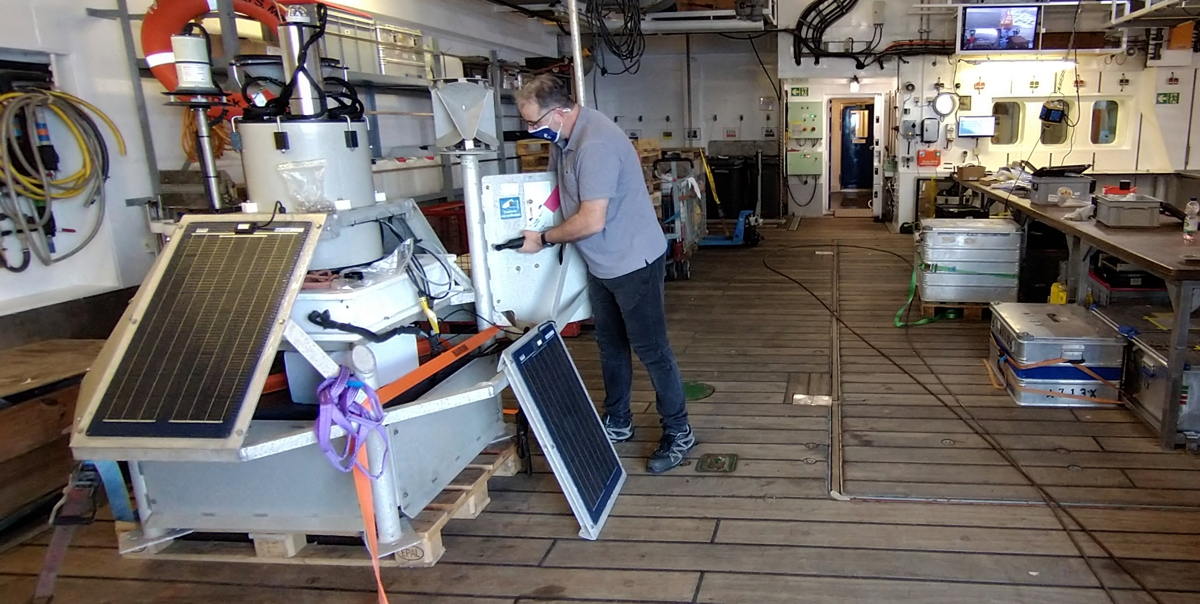
20 November - installing the dust collectors
On the highest deck of RV Maria S. Merian, we have installed two dust collectors, with which we will sample Saharan dust offshore NW Africa. These two blue 'mail boxes' each contain a vacuum-cleaner engine, which pumps air through an A4-sized paper. A wind vane makes sure that the samplers will switch off as soon as we have a tail-wind, so avoiding potential contamination from the ship's chimney. A rain sensor makes sure that the samplers do not suck water into the collectors. It will be a few days before we are allowed to sample the air in international waters.
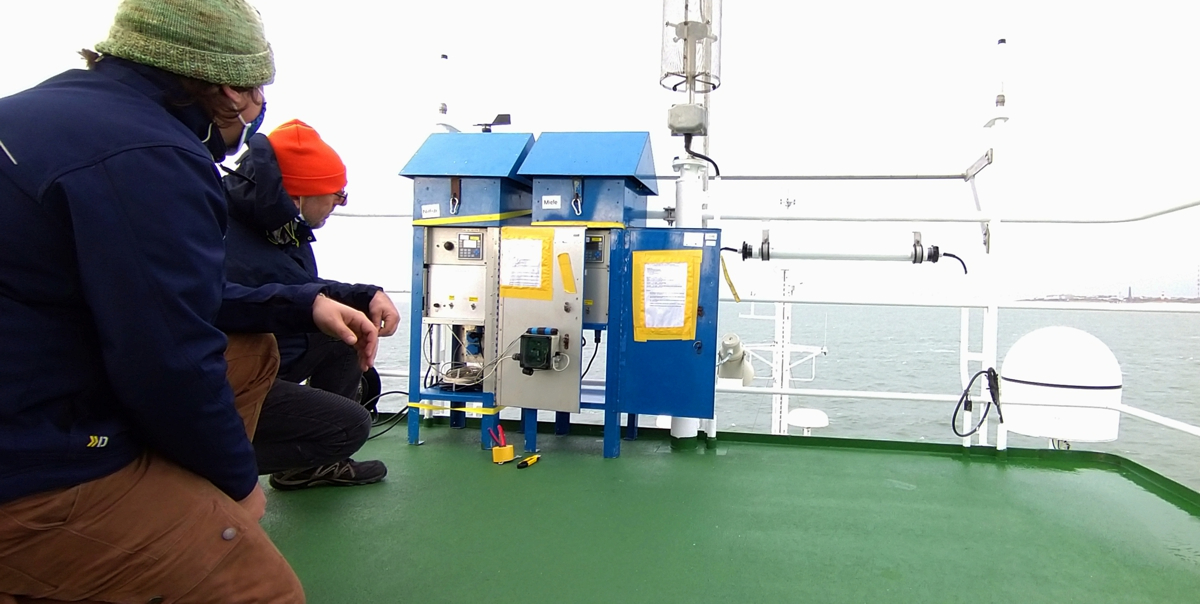
19 November - passing through the English Channel
On this screenshot one can clearly see how busy traffic is in the narrow channel between England and France, with large container vessels sailing North and South, ferries sailing East and West and fishing boats going in virtually all directions.
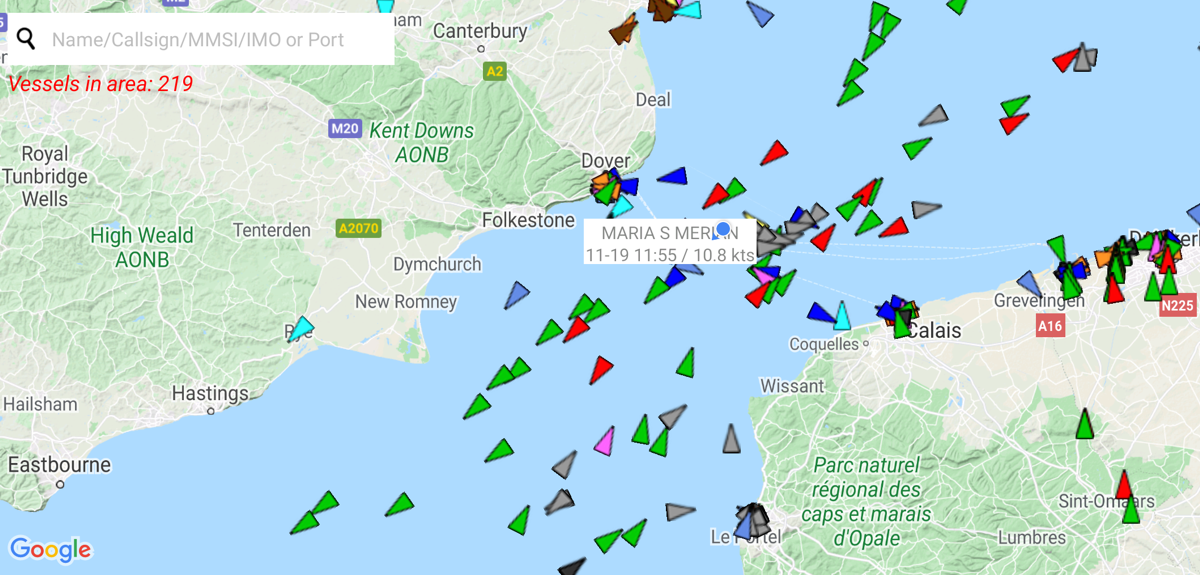
18 November - inslingeren / getting accustomed to the ship's movements
18 November - leaving Emden
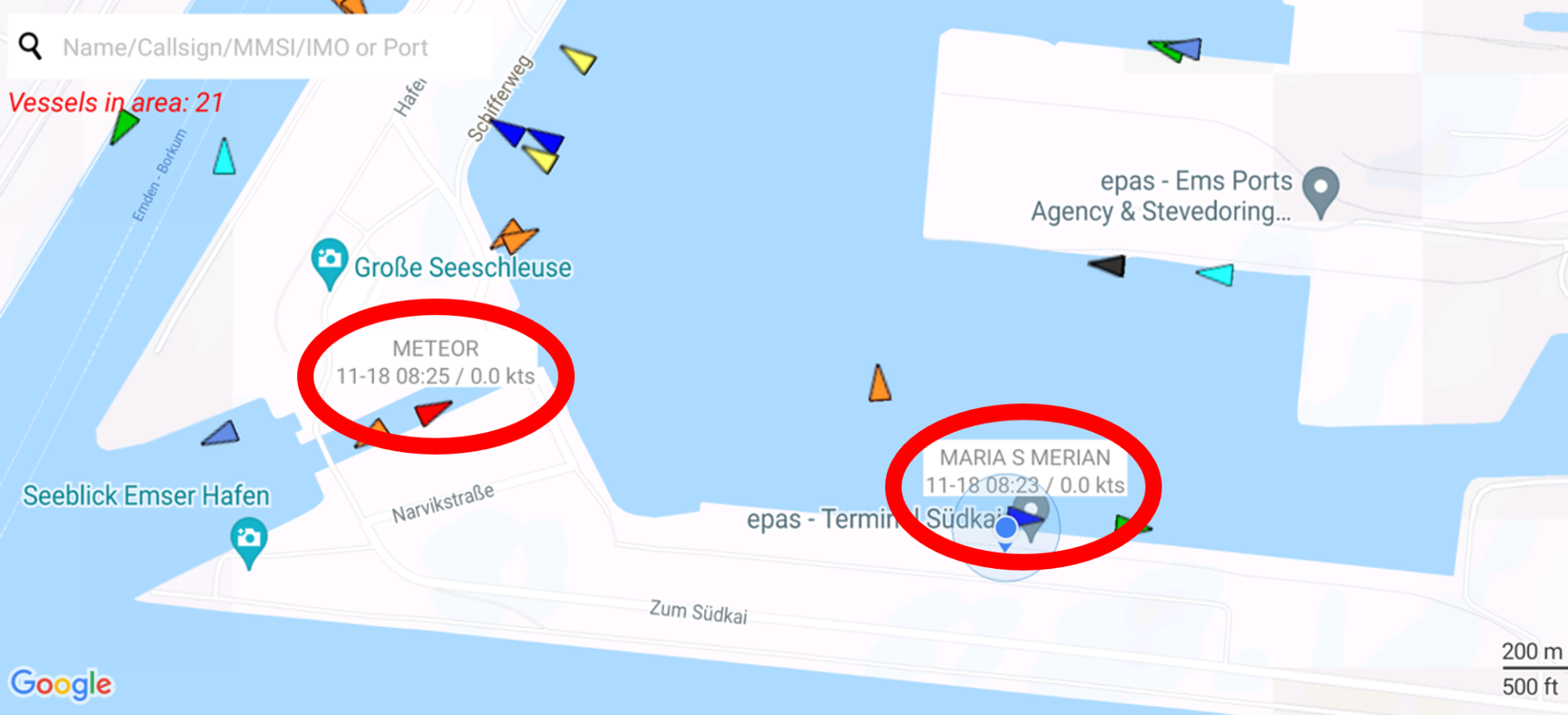
18 November - leaving Emden
After all the preparations it is now time to set sail for MSM104 - SIPA. We are scheduled to leave at 8.30 in the morning and --leave it to German punctuality-- right at that moment one of RV Maria S. Merian's sisterships, RV Meteor, is passing through Emden's sluice to take our spot in the harbour of Emden.
2 November - preparations: second outdoor test of the rain samplers
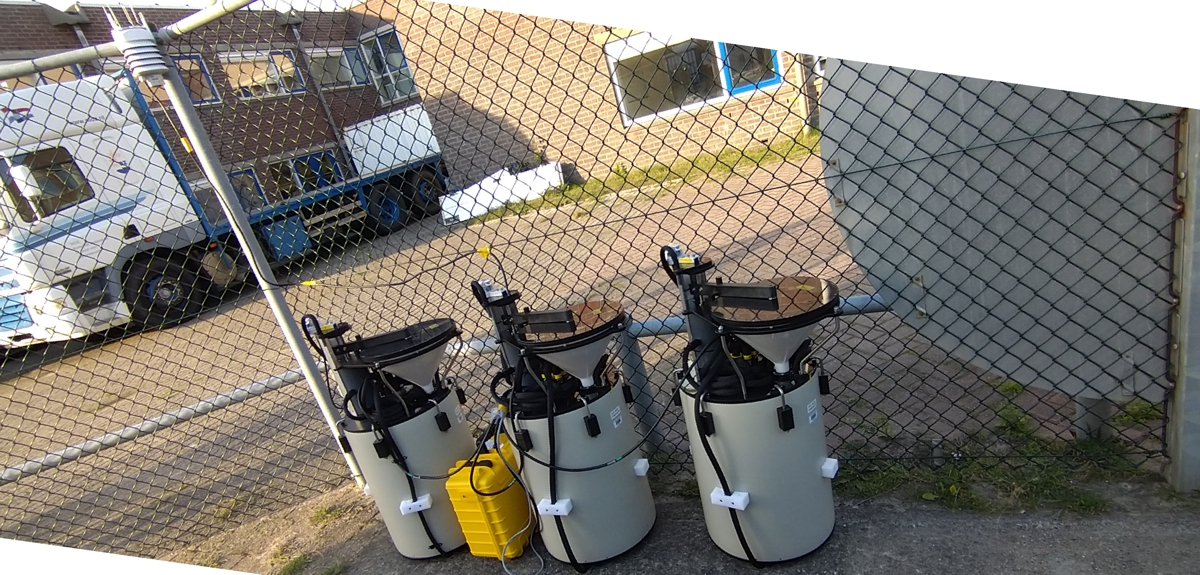
Three of the newly constructed rain samplers are being tested under 'real' conditions. Although the weather looks nice for the moment, rain is forecasted and we will leave the samplers 'alone' for three days to collect it.
On the buoys on the ocean the samplers will get their power from the solar-powered batteries. Here, on land, they get their power from a small battery inside the little yellow box. At the top of the fence you can spot the Vaisala weather sensor, which we use to calibrate the amount of rain that is registered by the rain sensors on the rain samplers as well as the amount of water collected by the samplers.
Let it rain!
18 October - preparations: first outdoor test of the rain samplers
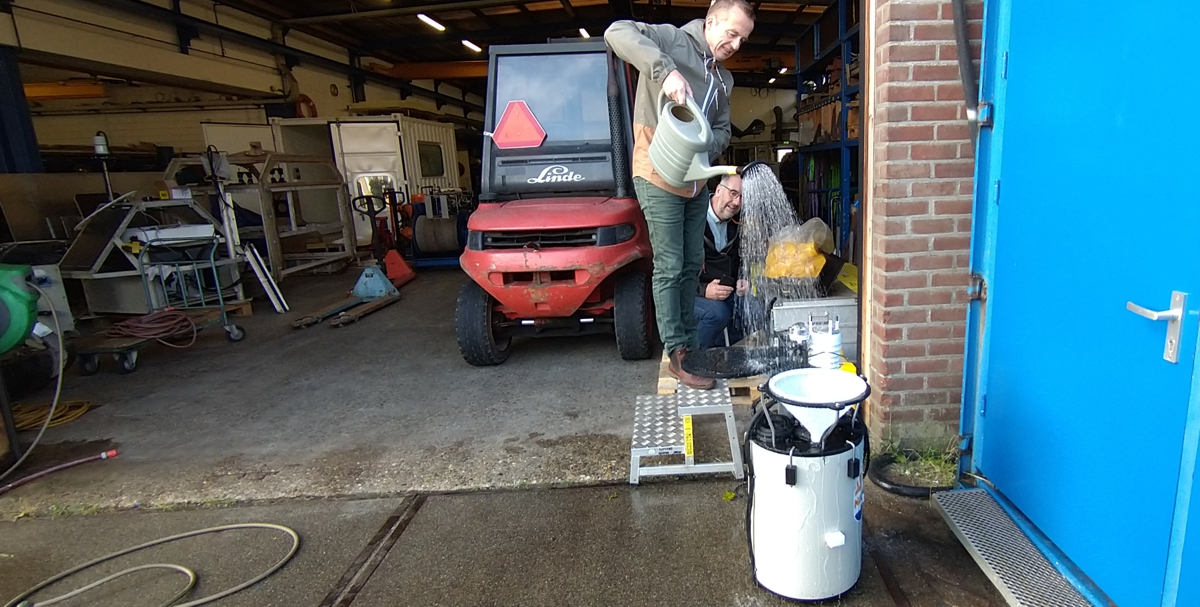
After the lab tests were completed it is now time to feed the rain samplers some 'even-more-real' rain. Here you see Jan-berend and Bob testing one of the samplers with some artificial intense rain. In addition, we are trying to calibrate the sampler's rain sensor with the Vaisala meteosensor with which the buoys are equipped as well. The sampler responded well to the watering-can rainshower; the lid opened and water is being collected by one of the perspex tubes inside the sampler.
15 October - preparations: first test of the rain samplers
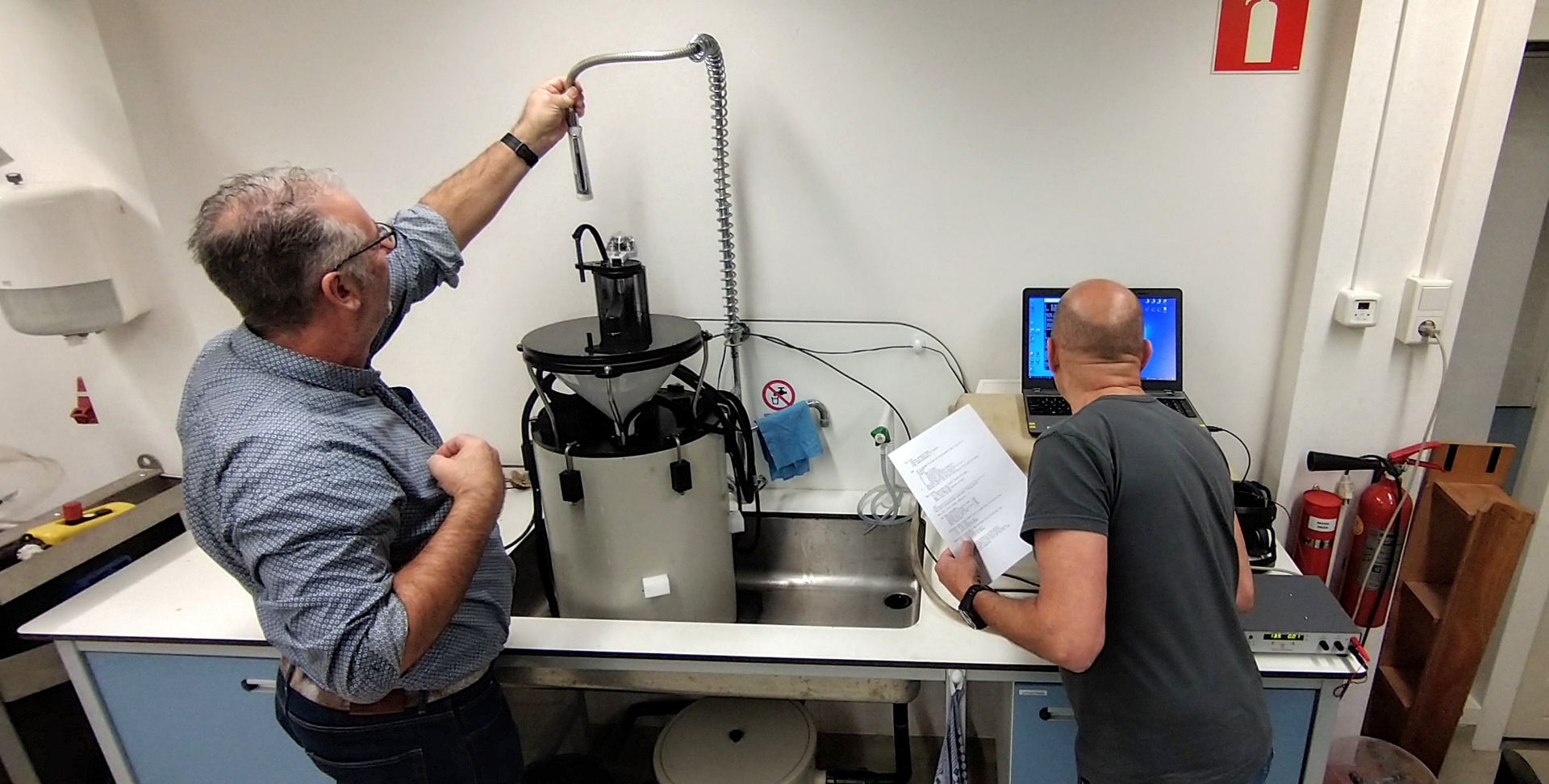
The rain collectors are ready to be tested and here you see Bob and Frank performing the first series of tests with artificial rain insde the lab. The rain sensor needs to be able to discern between sporadic spray and 'real rain'. It then needs to open the funnel and sample until either the rain has stopped or the bottle is full. This requires quite some sensors and programming lines but so far everything is working quite allright!
12 October - constructing a new instrument: the rain sampler
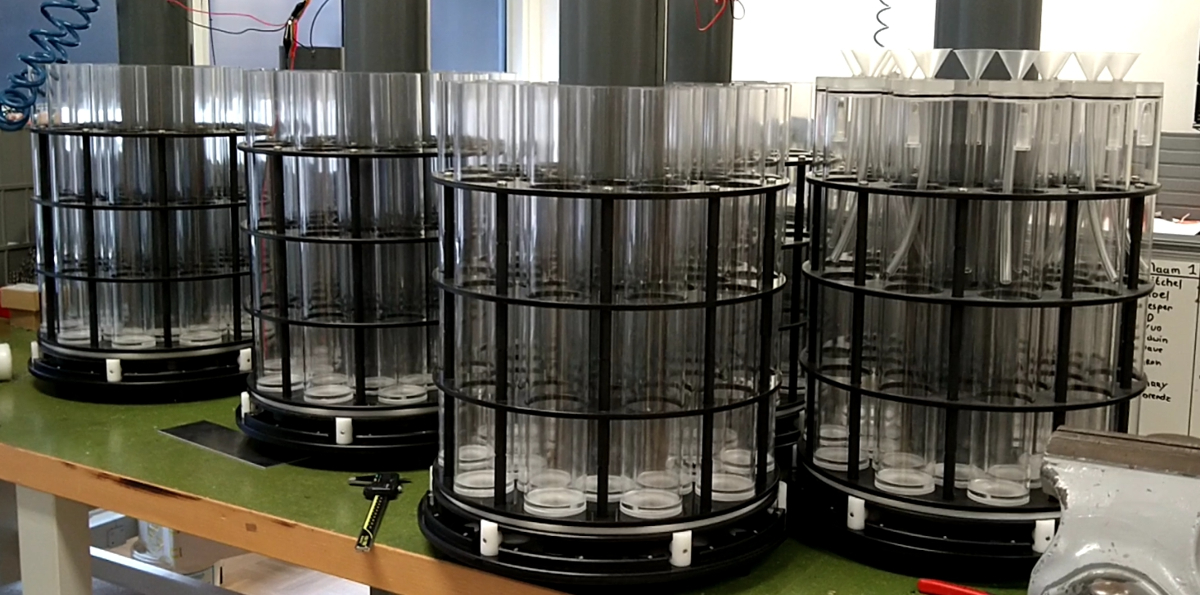
During one of the last expeditions we have carried out below the Sahara dust plume, we have discovered the importance of Saharan dust being deposited with rain; one single rain shower resulted in almost 1g of dust per m²!. To quantify the amounts that are deposited throughout the year, NIOZ technicians have designed a rain sampler, which they are now constructing and testing. Here you see five carrousels with bottles that will be the core of these rain samplers. On the right-most set of bottles you can see little funnels that will rotate underneath a large funnel that lets in rain into the sampler. To be continued....
10 October - preparations - fixing the mast of the dust-collecting buoys
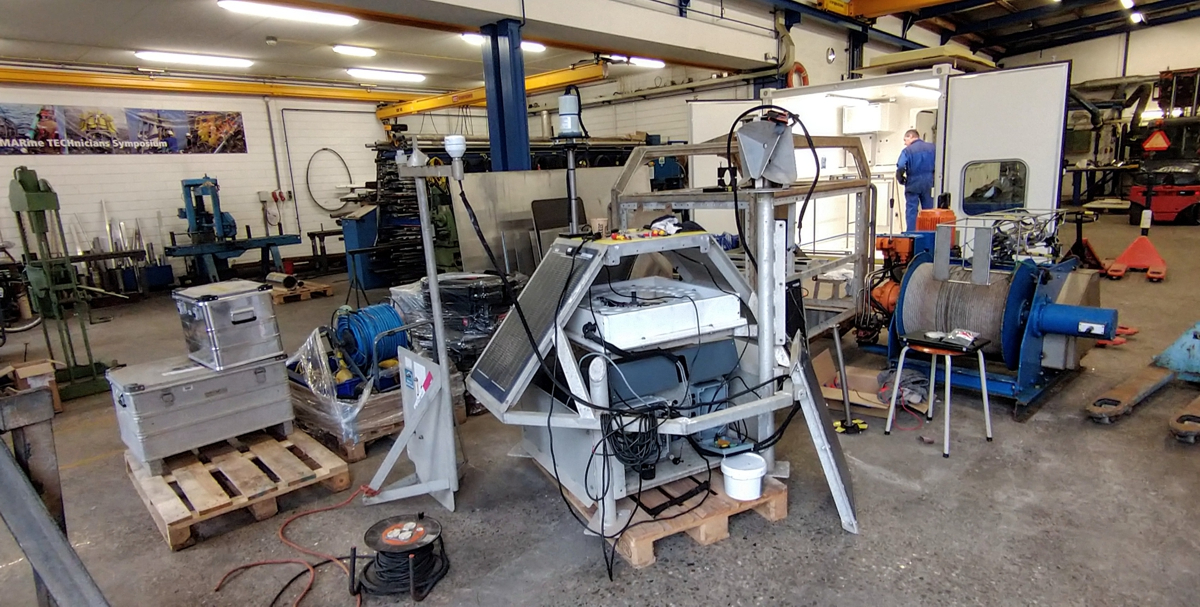
To be able to service the dust-collecting buoys as swiftly as we can --shiptime is costly!-- we are already preparing a tower with all required instruments so that, at sea, we only have to exchange the buoys' tops. Here you get a peek inside the dust tower; the white box shows the carrousel on which the dust filters will be mounted.
